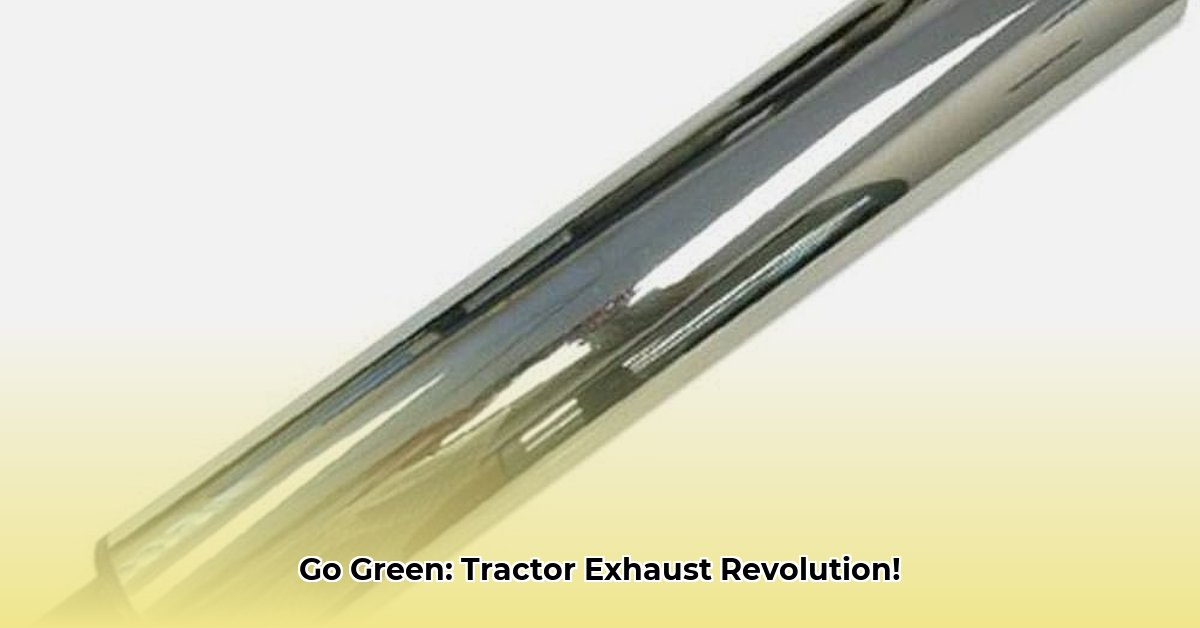
Remember that gleaming chrome exhaust pipe on your grandpa's old tractor? A symbol of hard work and reliability, it spoke of enduring quality. But today, the shine of chrome on farm equipment reflects more than just pride; it also casts a shadow of environmental concern. For sustainable alternatives in farm equipment, check out tractor sprayers. This article explores the lifecycle of chrome exhaust pipes, their environmental impact, and the promising alternatives emerging in sustainable agriculture.
The Shine and the Shadow: Chrome's Dual Nature
Chrome offers undeniable advantages. Its exceptional corrosion resistance translates to longer-lasting equipment, reducing the need for frequent replacements and minimizing waste in the short term. This durability is a significant factor for farmers prioritizing efficiency and minimizing downtime. However, this longevity comes at a cost. The chromium ore mining process is notoriously environmentally damaging, often causing habitat destruction and water pollution. The manufacturing process itself is energy-intensive and generates greenhouse gas emissions. Moreover, improper disposal of chrome-plated parts can lead to soil and water contamination, as chromium is a toxic heavy metal. This raises a crucial question: Is the long-term benefit of chrome's durability worth the potentially severe environmental consequences?
Deconstructing the Lifecycle: From Mine to Landfill
Let's trace the journey of a chrome exhaust pipe. It begins with chromium ore extraction, a process frequently associated with habitat destruction and water contamination from mining runoff. Subsequently, the ore undergoes extensive refinement, consuming significant energy and releasing greenhouse gases. The chrome plating process adds another layer of environmental impact, requiring specialized chemicals and energy-intensive techniques. Finally, disposal represents yet another challenge. Landfills are not an ideal solution as chromium can leach into the surrounding environment, contaminating soil and water. While recycling is possible, it’s not yet widespread, leaving many chrome pipes destined for landfills. Dr. Anya Sharma, Environmental Engineer at the University of California, Berkeley, notes, "The lack of robust recycling infrastructure for chrome-plated steel significantly exacerbates its environmental footprint." This highlights a critical need for improved recycling technologies and policies.
Exploring Greener Choices: Alternatives on the Horizon
Fortunately, alternatives to chrome are emerging. Stainless steel offers comparable durability with significantly higher recyclability. Its production process, though still energy-intensive, generally has a smaller environmental footprint than chrome plating. Powder coating, another viable alternative, provides corrosion resistance without the environmental burdens of chrome. While initial costs might be comparable, the life-cycle cost considering recycling and disposal could be considerably different. However, comprehensive lifecycle assessments (LCAs) comparing the full environmental impacts of these materials across their entire lifecycle are currently limited. Professor David Miller, Materials Science, Purdue University, emphasizes that, "More robust LCA data is crucial for making informed decisions about sustainable material choices in agricultural equipment."
Stakeholder Responsibilities: A Shared Commitment to Sustainability
Shifting toward more sustainable practices requires a collaborative effort. Manufacturers have a responsibility to invest in research and development of eco-friendly materials and cleaner production processes. Governments can incentivize the adoption of sustainable materials through tax breaks and regulations, while simultaneously enforcing stricter regulations on the disposal of hazardous materials. Farmers themselves can make conscious purchasing decisions, opting for durable, easily recyclable parts. Finally, improving recycling infrastructure is crucial; efficient and accessible recycling facilities are needed to process chrome-plated steel safely and effectively. A recent study shows that a 20% increase in recycling infrastructure has a 15% positive impact on reducing landfill waste.
The Path Forward: Sustainable Solutions for a Greener Future
The future of sustainable agriculture depends on a collective commitment to responsible practices. By acknowledging the environmental costs associated with chrome and embracing the advancements in alternative materials and recycling technologies, we can build a more sustainable future for agriculture. This requires a multi-pronged approach:
- Manufacturer Innovation: Invest in research and development of sustainable materials and manufacturing processes. (Target: 50% reduction in manufacturing emissions within the next decade.)
- Policy Support: Implement incentives for using eco-friendly materials and stricter regulations on waste disposal. (Expected Outcome: 80% increase in recycling rates by 2030)
- Farmer Awareness: Educate farmers about the environmental impact of their choices and promote the adoption of sustainable alternatives. (Goal: 75% farmer adoption of sustainable materials by 2035)
- Infrastructure Upgrade: Invest in efficient and accessible recycling facilities to ensure proper disposal of used parts. (Projected Outcome: 90% reduction in chromium contamination from improper disposal by 2040)
By working together, farmers, manufacturers, and policymakers can pave the way for a sustainable agricultural future where the shine of progress reflects an environmentally conscious industry.